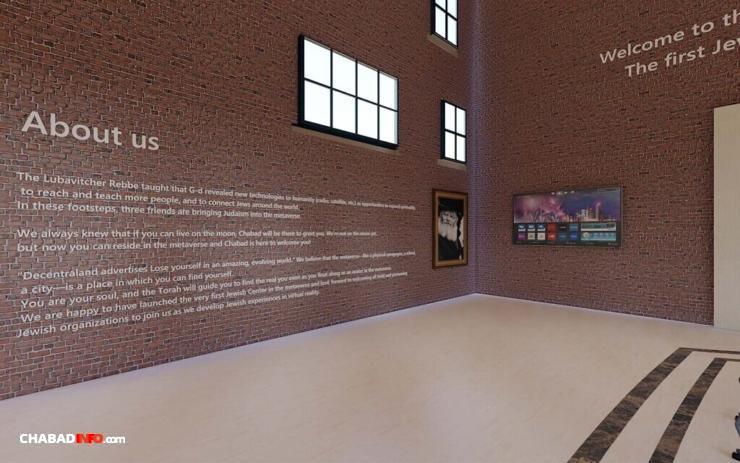Chabad Pioneers First Jewish Outpost in Virtual World
The Chabad-Lubavitch movement’s newest center will be the first Jewish outpost in the metaverse, a virtual world that is still in its infancy. Its construction may mark the movement’s initial foray into the new digital frontier, but it is part of Chabad’s generations-long strategy of Jewish outreach • Full Story, Photos
Times of Israel
The MANA Jewish Center will sit on a modest, grassy patch of land, circled by trees and pink flowers that pop up from underneath rocks. Craggy mountains are visible in the distance and clouds glide silently overhead, while next door a massive, black pyramid floats in the sky with streaks of blue light tracing up its sides.
The Chabad-Lubavitch movement’s newest center will be the first Jewish outpost in the metaverse, a virtual world that is still in its infancy. Its construction may mark the movement’s initial foray into the new digital frontier, but it is part of Chabad’s generations-long strategy of Jewish outreach.
“We’re new age, but old school. Our principles haven’t changed but we know how to adapt to the modern day and then apply the principles of yesterday to today,” said Rabbi Shmuli Nachlas, who is leading Chabad’s metaverse project with his longtime friend Rabbi Yisroel Wilhelm and tech expert Alex Gelbert.
The metaverse is imagined as a three-dimensional virtual world where people can mingle for work and play through avatars, or digital representations of themselves, in a kind of internet come to life.
It is a hazily defined buzzword that took off in the past year, lumped in with other trending and related tech topics including the blockchain, NFTs, crypto and Web3. The term dates back to 1992, though, coined by the American sci-fi writer Neal Stephenson in his novel “Snow Crash” as a portmanteau of “meta” and “universe.”
An early incarnation was the online multimedia platform Second Life, launched in 2003, which allowed people to socialize through avatars. Some online video games, such as the massively popular Fortnite and Roblox platforms, might qualify as proto-metaverses.
Facebook planted its flag in the metaverse, and shoved the term into public discourse, by rebranding as “Meta” last year (drawing mockery from Israelis, who quickly pointed out that meta means “dead” in Hebrew).
“The next platform and medium will be even more immersive, an embodied internet where you’re in the experience, not just looking at it, and we call this the metaverse, and you’re going to be able to do almost anything you imagine,” Mark Zuckerberg said in October. “We’ll be able to feel present, like we’re right there with people, no matter how far apart we actually are.”
Other tech titans including Microsoft, Apple and Google, and some Israeli companies, are also throwing their chips in, hoping to cash in on the Next Big Thing. Gamers have already spent millions on gadgets and garments in digital worlds such as Fortnite, virtual real estate companies have snapped up land, and the market for digital reality headsets and other accoutrement could soar into the tens of billions.
Proponents imagine a digital utopia, where individuals can roam free of all earthly bonds. Users could attend concerts, hang out with friends, look at artwork or go shopping. Naysayers see the potential for something darker — another online space where bad actors can engage in harassment, hate speech, bullying and privacy invasion. The sci-fi novel and Steven Spielberg film “Ready Player One” imagined users escaping into a virtual world called the Oasis as the real world crumbled around them.
The metaverse will emerge gradually and could end up being a radical break from our daily life with untold consequences. The early pioneers of the internet could not have foreseen Russian interference in US elections, or extremists radicalizing in chatrooms then shooting up synagogues and mosques. It could also become a more mundane continuation of our digital life today, where we already socialize on Instagram and hold work meetings on Zoom. For now, like the blockchain, NFTs or the nascent internet decades ago, it is a promising technology still seeking solid footing.
Either way, Chabad will have a presence in the digital realm. The Hasidic movement centered in New York City is famous for its outreach in the Jewish world, including with secular Jews. Its thousands of houses and outreach emissaries, known as shluchim, host Shabbat dinners wherever Jews set foot, from frigid Iceland and Alaska to the distant islands of Mauritius and Tasmania. The movement has also long used new technology to advance its goals.
Chabad is one of the world’s leading Hasidic movements and dates back to 18th-century Eastern Europe. It moved to New York City due to the ravages of World War II and the Holocaust, settling in Brooklyn’s Crown Heights neighborhood.
Rabbi Menachem Mendel Schneerson, revered by followers as the Rebbe (Yiddish for rabbi) or the Lubavitcher Rebbe, took the helm of the movement in 1951. The charismatic spiritual leader spearheaded a policy of outreach, in sharp contrast to the other great New York Hasidic dynasty, the Satmar, who took a different path in their Brooklyn refuge after WWII by turning their corner of Williamsburg into a fortress of piety insulated from the outside, including from many other Jews.
Schneerson supported using technology to spread Chabad’s message and was an early proponent of outreach via radio.
Chabad’s iconic world headquarters at 770 Eastern Parkway in Brooklyn (or “770” for short), where Schneerson lived, has a broadcasting room with his portrait hanging above a phone bank. His talks were recorded on video starting in the 1970s and broadcast via satellite in the 1980s.
Chabad Rabbi Yosef Y. Kazen began digitizing Jewish documents and connecting with people on early online message boards in the late 1980s, before the world wide web existed, setting up what he called “Chabad-Lubavitch in Cyberspace.”
He saw the potential for Jewish education and outreach online by the mid-1990s and began taking programming classes, setting up Chabad.org in 1993 with Schneerson’s approval. The movement commemorated Kazen as the “Father of the Jewish Internet” when he died in 1998.
The MANA Jewish Center will be the group’s newest medium for outreach.
“We’ve always been very much on the cutting edge and have always been very early adapters to technology, and to whatever it is that’s going on, and trying to see — is it something we can use to be out there and to engage the youth,” said Nachlas, who runs a youth program in Toronto.
Nachlas said he was an early Facebook user, despite some people doubting the propriety of its use for a religious group. Not all platforms are suitable, though — he said the group decided the Snapchat social media app was not worth pursuing, for example.
“Look at Facebook and YouTube and many of these platforms. There’s tremendous amounts of positive opportunity. That doesn’t mean there’s not plenty of garbage out there, but that’s the world we know. There’s everything in good balance, so our job is to shine a light,” said Nachlas.
The group’s first outpost in the metaverse will be located in Decentraland, a sprawling virtual world that went public in 2020 and is still mostly empty. In Decentraland, anyone can design an avatar and enter as a “guest” on an internet browser. Users teleport around the realm by clicking on a map and the controls are easy to learn. It describes itself as “the first fully decentralized virtual world” and is governed by its registered community.
It remains a work in progress. The graphics are underwhelming for anyone who has played contemporary video games and the interface can be buggy. The land is peppered with empty structures devoid of people and blank billboards, like an earthly neighborhood that is still under construction. The purpose of many buildings is unclear, even after going inside, at least to the casual user. There are relatively few simultaneous users and it’s rare to see anyone in many areas. Video of a recent “rave” went viral for the wrong reasons, since avatars still can’t dance.
Decentraland may be the closest thing yet to the metaverse envisioned by people like Zuckerberg, though. (Facebook’s metaverse has not yet been released.) There are fashion, shopping and art districts. Galleries display digital artwork on their walls and a casino hosts blackjack games underneath advertisements for boxing matches. There are eye-popping plazas and a museum in Dragon City that exhibits Chinese art and calligraphy. It’s fun.












269
Join ChabadInfo's News Roundup and alerts for the HOTTEST Chabad news and updates!









































